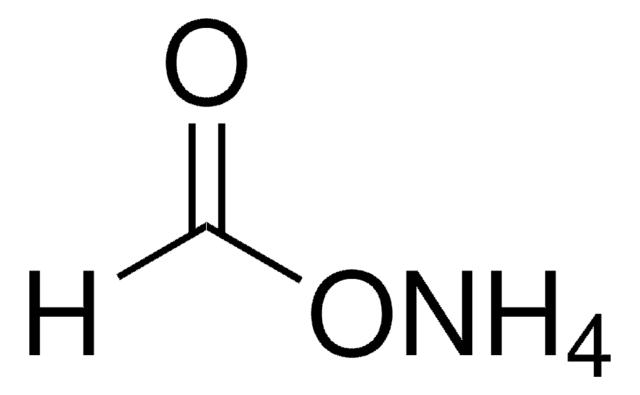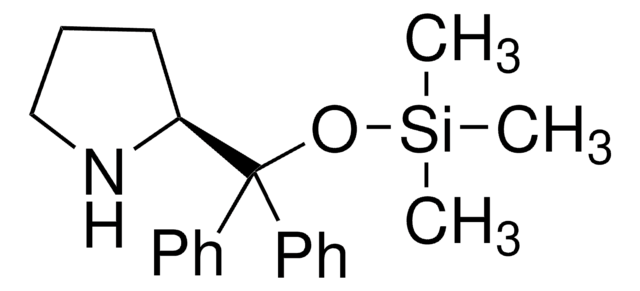679186
Acetonitrile solution
suitable for HPLC, contains 5 % (v/v) water, 0.1 % (v/v) formic acid, 0.05 % (w/v) ammonium formate
Sinonimo/i:
ACN, Cyanomethane, Ethyl nitrile, Methyl cyanide
About This Item
Prodotti consigliati
product name
Acetonitrile solution, contains 0.05 % (w/v) ammonium formate, 5 % (v/v) water, 0.1 % (v/v) formic acid, suitable for HPLC
Densità del vapore
1.41 (vs air)
Livello qualitativo
Tensione di vapore
72.8 mmHg
Forma fisica
liquid
contiene
0.05 % (w/v) ammonium formate
0.1 % (v/v) formic acid
5 % (v/v) water
Limite di esplosione
8 % (lit.)
tecniche
HPLC: suitable
P. eboll.
81-82 °C (lit.)
Punto di fusione
-48 °C (lit.)
Densità
0.782 g/mL at 25 °C
0.807 g/mL at 25 °C
Formato
mixture
Stringa SMILE
CC#N
InChI
1S/C2H3N/c1-2-3/h1H3
WEVYAHXRMPXWCK-UHFFFAOYSA-N
Cerchi prodotti simili? Visita Guida al confronto tra prodotti
Descrizione generale
Applicazioni
- Detection of Amino Acids via Chemiluminescence: Acetonitrile is employed in the detection of α-amino acids using peroxyoxalate chemiluminescence. A study demonstrated the use of a mixed solution of water, acetonitrile, and ethyl acetate for detecting amino acids, highlighting its efficacy in analytical applications. This method enhances the sensitivity and accuracy of amino acid detection, making it crucial for biochemical and clinical analyses (Kan et al., American Journal of Analytical Chemistry, 2020).
- Redox Properties of N-Hydroxyimides: Acetonitrile mixed with sulfuric acid is used to study the redox properties of N-hydroxyimides, acting as a hydrogen atom transfer (HAT) mediator for alcohol oxidation. This application is significant in understanding the electrochemical behavior of organic compounds and developing new catalytic processes for oxidation reactions (Kishioka, Journal of Electroanalytical Chemistry, 2023).
- Electrode Reactions in Catalytic Mediation: Acetonitrile solution is used in investigating the electrode reactions of N-hydroxyphthalimide in sulfuric acid. This study focuses on its role as a catalytic mediator for alcohol oxidation, providing insights into the electrochemical mechanisms involved. The findings contribute to the development of efficient catalytic systems for organic transformations (Kishioka, Journal of Electroanalytical Chemistry, 2022).
- Excitation of Europium Complexes: Acetonitrile solution is utilized in the interaction of Eu(FOD)3 with xenon difluoride to study ligand-assisted excitation of Eu(III). This research explores the photophysical properties of europium complexes, which are essential for developing luminescent materials for various applications, including lighting and display technologies (Masyagutova et al., Journal of Fluorine Chemistry, 2024).
Nota sulla preparazione
Avvertenze
Danger
Indicazioni di pericolo
Classi di pericolo
Acute Tox. 4 Dermal - Acute Tox. 4 Inhalation - Acute Tox. 4 Oral - Eye Irrit. 2 - Flam. Liq. 2
Codice della classe di stoccaggio
3 - Flammable liquids
Classe di pericolosità dell'acqua (WGK)
WGK 2
Punto d’infiammabilità (°F)
36.0 °F - closed cup
Punto d’infiammabilità (°C)
2.22 °C - closed cup
Dispositivi di protezione individuale
Eyeshields, Faceshields, Gloves, type ABEK (EN14387) respirator filter
Scegli una delle versioni più recenti:
Possiedi già questo prodotto?
I documenti relativi ai prodotti acquistati recentemente sono disponibili nell’Archivio dei documenti.
Il team dei nostri ricercatori vanta grande esperienza in tutte le aree della ricerca quali Life Science, scienza dei materiali, sintesi chimica, cromatografia, discipline analitiche, ecc..
Contatta l'Assistenza Tecnica.



![(S)-α,α-Bis[3,5-bis(trifluoromethyl)phenyl]-2-pyrrolidinemethanol trimethylsilyl ether 97%](/deepweb/assets/sigmaaldrich/product/structures/396/398/09a397b1-b5f5-420f-98da-adf9017cef56/640/09a397b1-b5f5-420f-98da-adf9017cef56.png)


